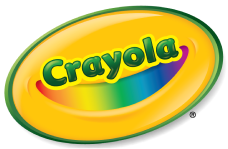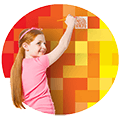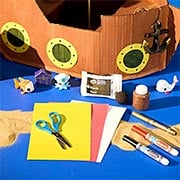Junto con la sede corporativa, Crayola opera varias instalaciones de fabricación en toda el área de Lehigh Valley de Pensilvania. Aunque ya no ofrecemos recorridos, la compañía abrió su primera Experiencia Crayola en 1996 en el centro de Easton, Pensilvania, donde se anima a los niños de todas las edades a jugar, explorar y aprender.
Crayola Experience es el único lugar en el mundo donde la magia de Crayola cobra vida. Explore exhibiciones divertidas, haga manualidades e incluso pruebe nuevos productos. ¡Se anima a todos a dejar volar su creatividad y colorear fuera de las líneas en Crayola Experience!
Puede visitar una ubicación de Crayola Experience en Easton, PA; Orlando, Florida; Minneapolis, MN; Plano, TX; y Chandler, AZ. Comience a planificar su viaje visitando el sitio web de Crayola Experience.
También podemos acercarle nuestro mágico mundo de color con actividades interactivas guiadas en video en los Kits de Aventura en el Hogar de Crayola.
No olvides visitar The Crayola Store después de ver esta atracción única.
Si tienes preguntas adicionales, ¡nos encantaría saber de ti! No dudes en llamarnos o enviarnos un mensaje de texto al 1-800-CRAYOLA días laborables entre las 9 AM y las 4 PM hora del Este. Si prefieres enviarnos un correo electrónico, visita nuestra página de contacto.
Preguntas relacionadas
Explora respuestas a preguntas comunes, consejos útiles para eliminar manchas e ideas creativas para aprovechar al máximo nuestros materiales de arte y recursos gratuitos.
-
Many Crayola products do not state age recommendations on packaging because the age when a child is ready to begin using art products varies from child to child. Some children are ready to use art products at a very early age, while others may not show an interest until later. Crayola offers a range of art supplies and creative activities designed specifically for children ages 12 – 36 months. View products for toddlers on Crayola.com!
-
Crayola Sidewalk Chalk is a molded chalk made of Plaster of Paris and color pigments. Although it is designed to be used on sidewalks and driveways, the chalk contains colorants, which may stain clothing and other household surfaces. If the chalk is used on a newly poured sidewalk or driveway, there is a possibility that the open surface pores in the concrete could absorb the colors.
We suggest testing Crayola Sidewalk Chalk in an inconspicuous area and then washing it away with water. In most cases, chalk markings wash away with the first rainfall if used on a paved or poured surface that is more than two years old.
Crayola offers stain removal suggestions as a service to consumers. You can find this information on the Crayola Stain Removal Tips page.
Please bear in mind that while all stain removal suggestions have been tested in our laboratory, results are not guaranteed. We recommend testing any suggestion in an inconspicuous area first.
If you have additional questions, we would love to hear from you! Feel free to call or text us at 1-800-272-9652 weekdays between 9 AM and 4 PM Eastern Time. If you prefer to send us an email, please visit the Crayola Contact Us page.
-
We hope the following tips help you enjoy hours of fun with the Digital Light-Designer!
Troubleshooting tips if the unit is not functioning as expected:
- Check that new, fresh batteries are being used and installed correctly.
- The unit needs to be placed on a flat, hard, level surface so the switch underneath is engaged.
- Does the Red LED on the wand light up? If not, check the batteries are in properly and are new.
- If you cannot get past the main menu screen, turn off nearby lights in the room or move out of direct sunlight. Strong outside or indoor light can interfere with the operation of the unit.
- The wand is similar to a remote. It needs to be aimed rather than held like a pencil. It works from about an inch away, with the light beam on or tap wand directly on the dome surface.
- When the unit is turned on, the unit cycles the colors line by line. You can interrupt this process by tapping on the dome. If you don't see the colored lines, something in the room is causing interference.
- You cannot draw on the top of the dome, only the sides.
- To rotate the displayed image, hold the stylus on the dock (the 2 white lines near the base). The lines will turn red, then blue. When the lines turn blue, move the stylus along the dock to rotate the images around the Digital Light-Designer.
- There are 3 menus available; however, only 2 appear at first.
- Two wands CANNOT be used at the same time. Two wands cause issues similar to having lights on in the room.
- What type of adapter are you using? USE ONLY AC ADAPTERS WITH MATCHING SPECIFICATIONS: INPUT: 100-120VAC, 50-60 Hz, 0.8A / OUTPUT: 6.0VDC, 2.0A, 12.0W/VA
The Crayola Digital Light-Designer is no longer a part of our current product line. You can learn more about our current products on Crayola.com.
-
It’s glow time! We have some tips to help you get the best results from Crayola® Glow Fusion.
- The Glow Fusion technology is a marker-paper system. The paper and marker set combined work together to give your masterpieces up to four hours of glow time.
- Protect your work surfaces. Glow Fusion Markers are not washable.
- When the markers (activated or not) are not in use, cap and lay them flat in the marker tray to prevent leaking.
- For the brightest glow effect, use the markers promptly after activating.
- To activate the markers:
- Bend the marker barrel at the star points to crack the glow capsules.
- Shake the capped marker for 5 seconds.
- Remove the cap and hold the marker tip down until it glows.
- Turn off the lights to see your art shine at its brightest!
Need a visual?
- Scan the QR code on the box or check out the video here.
Want to keep the creative fun glowing?
- Check for Glow Fusion Marker Coloring Sets in the Crayola aisle at retail stores or your favorite online shopping sites.
-
As we deepen our commitment to sustainability, we're researching what programs will make the most significant impact and help us advance our sustainability goals, like our commitment to significantly reduce emissions from our business operations by 2030.
We have already taken several steps to make our products and operations more sustainable by focusing our efforts on renewable energy and packaging initiatives.
- Renewable Energy: The 20-acre solar farm on our Crayola campus in Pennsylvania provides the electricity to make 1 billion crayons, 700 million markers a year, and 120 million jars of paint.
- Plastics Reduction: In the last 10 years, we've redesigned our broad line markers to save an estimated 2 million pounds of plastic versus its previous design.
- Packaging: We make our marker Classpack packaging with 100% recycled cardboard. Starting in 2023, this packaging, along with crayon sleeves, will be made with natural cardboard instead of bleached cardboard, which will reduce C02e emissions by an estimated 100 metric tons per year.
- Carbon Footprint: Crayola, through our parent company Hallmark, joined the Science Based Target initiative, a collaboration of global nonprofit organizations, businesses, and world governments that set goals to limit global warming to not exceed 1.5°C. To achieve this, participating organizations will need to reduce carbon emissions significantly by 2030. Crayola sources raw materials locally and manufactures many crayons and markers close to where they are used, which helps reduce the carbon footprint. In fact, Crayola has reduced CO2e emissions from our company-owned facilities' direct and indirect energy sources by 82% since 2019, with investments in renewable energy, as well as efficiencies in our US manufacturing process. (Direct energy includes the gasoline, oil, natural gas, etc. used while indirect emissions are created when the energy is produced but not where it is used.)
- Reforestation: Most Crayola colored pencils are made from wood that is reforested in an 8,288 hectare pine farm in Brazil. Each year 300,000 seedlings are planted to restore the forest.
For more information on Crayola sustainability efforts, check Crayola's Sustainability Page.


